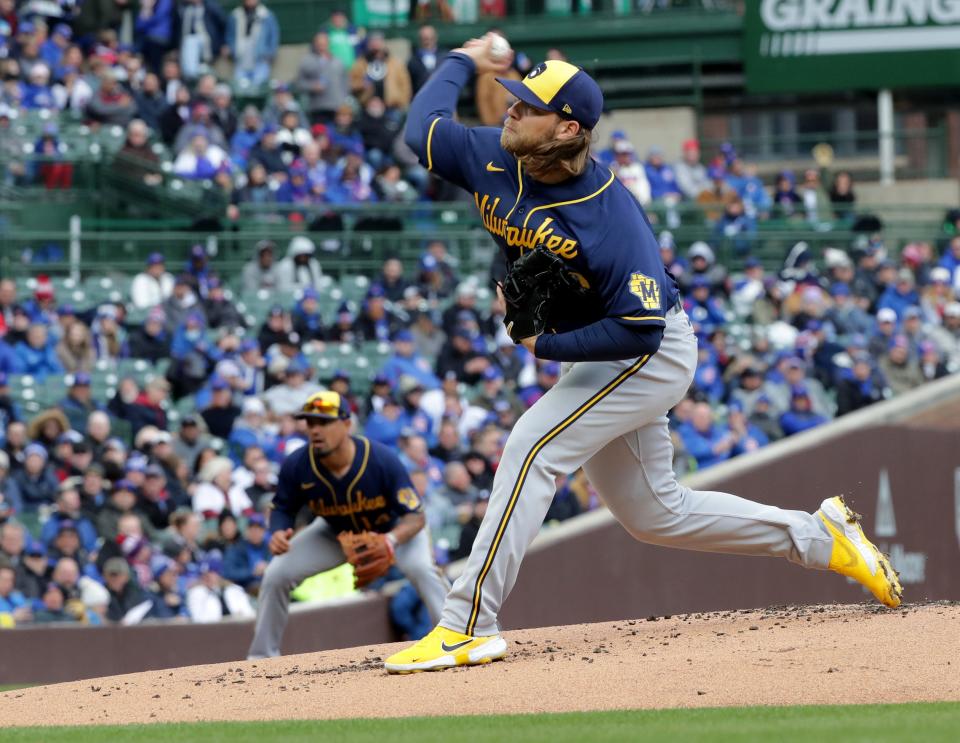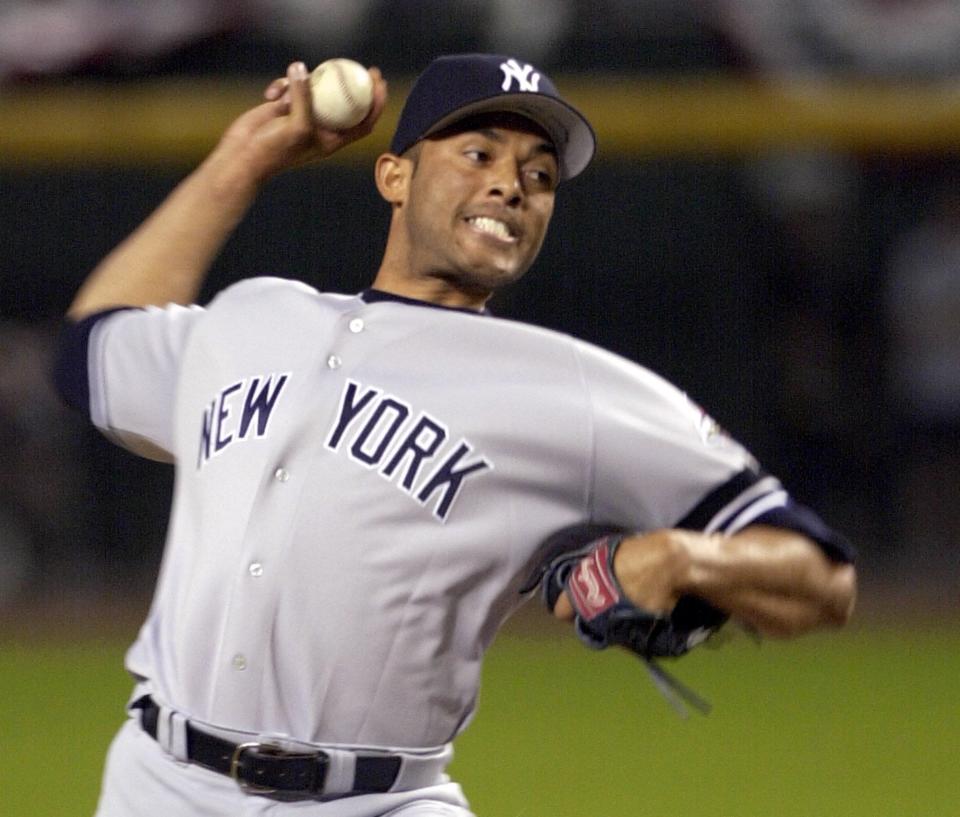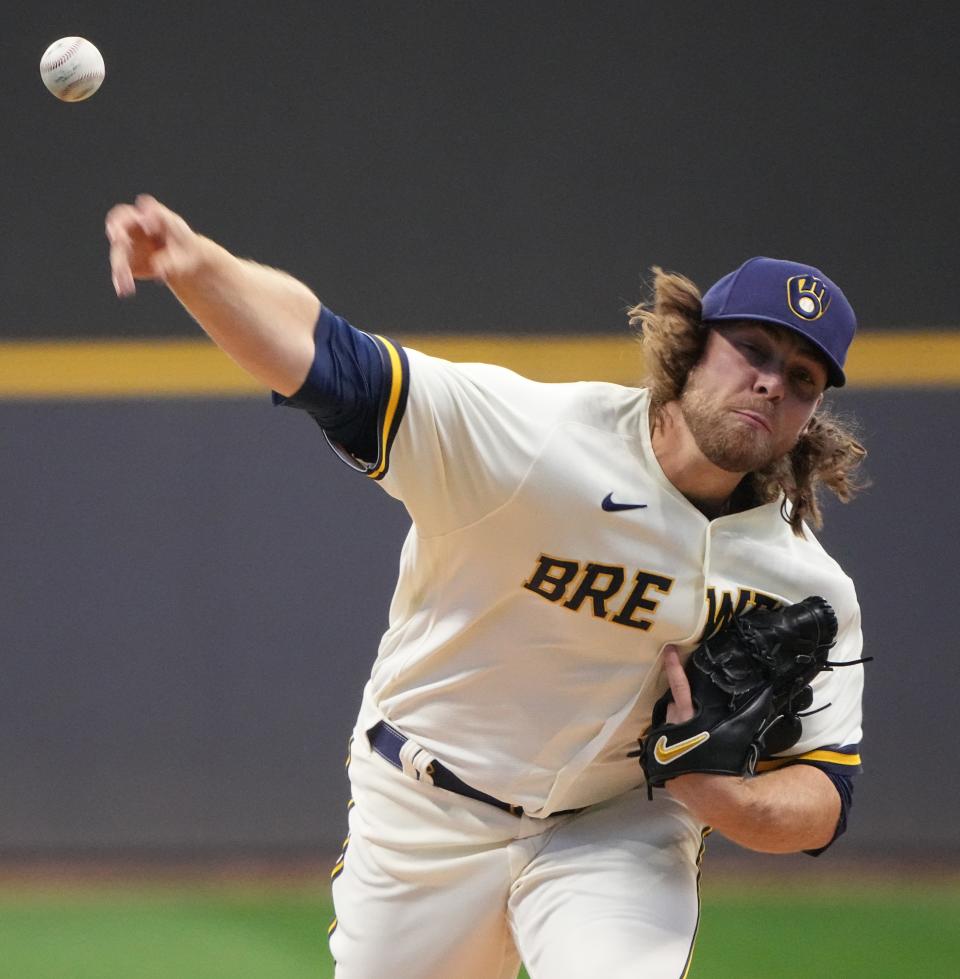Corbin Burnes, modern-day unicorn on the mound, will start opening day for the Brewers
PHOENIX – When Corbin Burnes takes the ball for the Milwaukee Brewers on opening day next week, he will do so on the same mound where he reintroduced himself to the baseball world three seasons ago.
It was a 2-0 count on the second batter of the second game of the 2020 season when Brewers catcher Omar Narváez called for Burnes to throw a backdoor cutter to Chicago Cubs first baseman Anthony Rizzo at Wrigley Field. It’s the exact same thing that has been called hundreds upon hundreds of times for Burnes. He's become renowned for it because of the lethal precision with which he executes it to dismantle batters.
But this time, with Burnes standing in front of no spectators at Wrigley, it was only a pitch he had never thrown in a big-league game before. Pomp was absent. But, nonetheless, the best pitch for arguably the best pitcher in baseball was born.
Burnes, the man who journals extensively about every outing, who recalls the most minor details about his craft, was asked if he has any memory of his very first cutter.
“I don’t remember it,” Burnes said. “I really don’t.”
It really was a nondescript beginning, then ‒ and not helping matters was the fact that Burnes missed outside by about five inches.
But a sequence almost immediately after gave perhaps the first public glimpse into what Burnes might become.
Ahead in the count 0-2 on Kyle Schwarber later in the inning, Burnes elevated a cutter that burned the top of the strike zone at 98 mph. Schwarber spoiled it, but his reaction – staring out at Burnes with an expression of bewilderment – said it all.
On the second cutter he ever threw in a major-league game, Burnes was already registering confoundment from one of the best hitters in baseball, so he doubled down, missing just outside with another cutter on the next pitch. That wasn't enough. He then tripled down and executed on the outside corner to perfection to freeze Schwarber.
He didn't know it at the time, but it was precisely the sequence and the strategy Burnes would use time and time again to become a Cy Young Award winner and one of the elite pitchers in the game: throw the heck out of the cutter and challenge hitters to beat it.

How Corbin Burnes learned his cutter could be a dominant pitch
When the Brewers announced Friday that Burnes would be the opening day starter for the second year in a row – the game is Thursday at Chicago – it made official what has been known for weeks now.
The fact the 28-year-old Burnes has reached this point, where he’s a bona fide star in the league and a no-brainer to get the ball on opening day, makes it easy to forget that, this time three years ago there were questions of if he would ever be able to start in the majors.
Burnes was coming off a disastrous 2019 in which he allowed 17 home runs. Only three pitchers had ever had a higher home runs per nine innings rate (3.1) while throwing as many innings as Burnes did that year (49).
During Burnes’ struggles in 2019, the Brewers boxed him into what kind of pitcher to be, Brewers manager Craig Counsell admitted recently. So while Burnes was working through how and when to utilize his new cutter, the Brewers let him lead the charge.
“I've told him, I think we made some mistakes there,” Counsell said. “I think we pigeonholed him a little bit too much. We didn't give him a little more freedom to do a bunch of things.”
Between the end of the 2019 campaign and when the major-league season ramped back up the following July, Burnes had developed a new weapon.
“Throwing the cutter at home into my net and everything during COVID, I didn’t know the metrics on it or how hard it was,” Burnes said, “but just from me physically throwing it and comparing it to my two-seam, I was like, ‘OK, it looks pretty hard. It looks like it’s moving pretty good. It looks like it might be pretty good.’”
Still, it took a few outings for Burnes to realize just how good the pitch might be. He showed flashes of its potential against the Cubs, particularly with its velocity, but command was inconsistent. Burnes’ cutter usage hovered around 20% through his first five outings of the season until a start in Pittsburgh for appearance number six resulted in 41% usage.
“I didn’t know what effect it was going to have, if it was going to be more of just a pitch that I could get ahead in counts with,” Burnes said. “The more I threw it, the more we got reads off guys swinging at it that let me know it was going to be a pretty good pitch.”

The closest comparison to Burnes' cutter may be Mariano Rivera's
It wasn’t just the swings that told Burnes he had something special. When the Brewers measured the cutter’s metrics during the summer camp buildup to the shortened season, they were astounded. There simply weren’t any cutters in the league that matched both Burnes’ shape – it gets excellent vertical rise and horizontal break – and his velocity.
It was a unicorn.
“Throwing bullpens on the TrackMan and stuff, they started to be like, ‘Hey, this is a pitch we haven’t seen in a long, long time,’” Burnes said. “Basically since Halladay or Mariano.”
Mariano Rivera? That Mariano Rivera?
“It has more vertical rise and horizontal break than any cutter, really, in the league matched with the velocity,” Burnes said. “Some guys can do it with more of a sliderish shape and the slider speed. But nobody has paired the movement profile with the velocity, really, since Mariano. Mariano, he’s really the only guy that has the velocity with it, though every now and again, Kenley Jansen throws a couple that are kind of similar to it.
“So just with the metrics and the velocity, it’s kind of a pitch that’s unmatched.”
Statcast’s pitch measurement database backs Burnes’ claim. Ever since he developed more horizontal break between 2020 and ‘21, there are only three pitchers who currently come close to matching his horizontal and vertical movement: Jansen, Nestor Cortes and Chris Flexen. None are coming close to matching his 95.1 mph average heat. A few pitchers, like Emmanuel Clase, can match or top his velocity, but none of those pitchers can match his movement.
"He was going to figure something out to get better,” Counsell said. “That's just how he does it. He's always trying to figure something out to get better. It's his nature. He's not really satisfied. He's just a person that doesn't feel satisfied. That's just who he is.”

Our subscribers make this reporting possible. Please consider supporting local journalism by subscribing to the Journal Sentinel at jsonline.com/deal.
DOWNLOAD THE APP: Get the latest news, sports and more
This article originally appeared on Milwaukee Journal Sentinel: Brewers name Corbin Burnes starter for 2023 opening day vs Cubs

